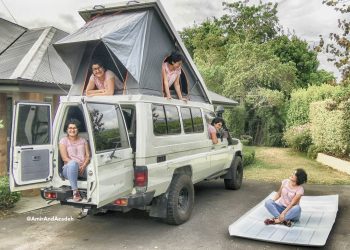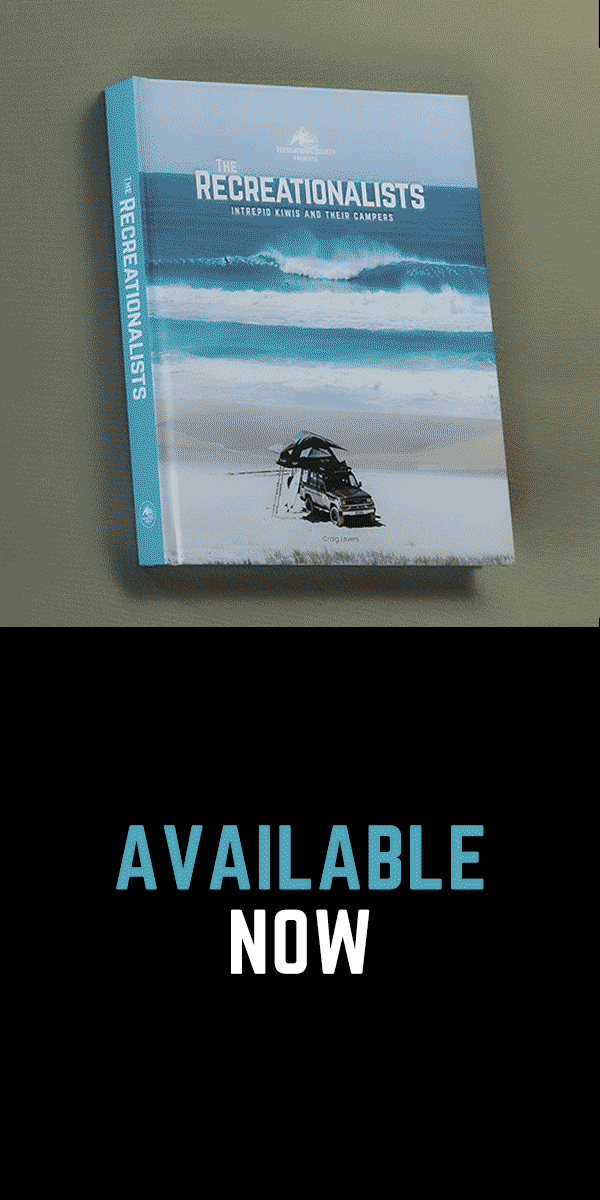Vanlab is a young start up doing great things. Intimidated by the cost of buying a camper or a gin palace on wheels? Freaking out about what a huge and unknown project actually fitting out a camper is? Well, Andy Jones has you sorted.
The concept and in fact the execution of VanLab is ingenious, as you’ll discover in this post…
Andy, you’ve got a PhD in Aeronautical Engineering, then you worked at McLaren Automotive designing supercars. Now you’re doing van fit-outs, what the heck, could you explain the lifestyle change?
Yeah, so my Undergrad degree was automotive engineering, with a PhD in aeronautical engineering. Then I did a stint at McLaren as an Aerothermal Engineer; all in the UK. After a couple of years at McLaren I decided I wanted to travel a little before settling into the career path. My Dad is a Kiwi and I have immediate family here, I decided to spend some time in NZ. I moved here couple of years ago, built a van and I spent 5 months travelling around the country. After that I did a stint as a Senior Product Development Engineer at Fisher & Paykel. Now I am running VanLab full time. However, deciding to run your own start-up in search of a work/life balance may have been misjudged!

Can you tell us more about why you’re doing campervan fitouts, tell us about Stevie aka Vanlab- Labvan mk1?
When I ran out of money travelling, it was time to find a job! This drew me to Auckland and in an effort to find some employment related to my training I got the job at Fisher and Paykel. They were a great employer, filled with great people. It was a melting pot of engineers from around the world who all wanted to continue in engineering, but wanted to live in NZ. Our team of 8 had 7 different nationalities with a range of disciplines including deep-sea mining, automotive, aeronautical and academia! However, I was really interested in starting my own thing. I was at a mountain film festival tour last year and heard this story about a lady who was pursuing art and mountain biking full time. She said, “Sometimes you’ve got to build something you want to be a part of”. It stuck with me. I went away and built something that allowed me to combine my interest of engineering with an application I was passionate about. And this lead to VanLab!

Originally, I built my first van (“Stevie”) at my parents’ holiday home in Nelson. It took about 2-3days to design, with a heap of 2D scaled drawings, and then 3 weeks to complete the build. It was a really fun project, but the build time was massive. We had daily trips to hardware stores, auto electrical stores and timber merchants for materials, tools and consumables to supply our ‘drive way workshop’. This is the thing that really saps time during the build. Anyways, when finished, she looked awesome! In the months following she got a heap of praise from other backpackers and Kiwi travellers alike. It got me thinking, maybe I could use some of my engineering experience to turn Stevie into a flatpack solution, and allow other people to build their own too. With a VanLab kit, we have reduced the 3 week build time to a self-build single day!
Flat packs van fit outs are common in the UK, was seeing them there a part of your decision to start here?
To be honest the decision to go flatpack was purely to allow people to build their own kits quickly. I hadn’t actually seen any of the kits from the UK before designing ours. As we were travelling, I kept hearing the same stories about people being sold unreliable vans with poor fit-outs for quite serious money. I really wanted to help bring some transparency to the process. Allowing people to decouple what they spend on their van and what they spend on their fit out. This way, there’s no dressing up mechanically terrible vans with fancy throws, yoga mats and sunset photography!
This set my main design goals; the fit out must be high quality, quick to build, require minimum tools, be built anywhere and price competitive.
To do this, I designed our kits with all the panels pre-cut for you. The pilot holes pre-drilled, each panel is numbered sequentially with the build, each pilot hole has an engraved symbol to show the orientation it should be screwed in. I developed a slot and tab system where each panel has a unique arrangement. This means the common parts fit everywhere and the unique parts only fit in the correct place following the Japanese Poka Yoke principles (meaning mistake-proof) of assembly. The whole thing can be built with 2 screwdrivers, which we even provide in the kit!
To ensure we were price competitive, I undertook an extensive TradeMe search. I found that on an average of 62 identical vans (age, transmission, manufacturer etc.) a campervan sold for $5,500 more than an empty van. So, I knew I could price my complete kits for under this figure, allowing people to build their own, travel and recuperate their money.

The design you’ve gone for is a lot different than your standard ‘benches down the sides, kitchen at the back or front’. How’d you settle on that?
This is an interesting questions and one I get asked a lot! There is a whole bunch of reasons we settled on this design. It took a heap of 2D scaled drawings and 3D designs to optimise the 4m^2 to be a living room, bedroom, kitchen, toilet and dining room.
Firstly, these vans are ‘sit down’ vans, even the high tops don’t have enough room to stand in comfortably. From here, I wanted to be able to sit while I cooked and washed up inside, and stand while I used the kitchen outside. I also wanted to maintain ingress/egress from both slide doors, as this is a really useful feature for two people travelling. These requirements dictated that the kitchen should be at the back. We developed the U shaped benchtop for kitchen ergonomics. It doubles up as a space to use the toilet while the bed is made up (to comply with current self-containment regulations).
Keeping the whole thing under the window line was tricky. We had to balance the height of the benches, table and worktop to successfully store the toilet, produce an ergonomically sound kitchen and table, and to be a comfortable height to use from outside!
The table is big enough for 4 people to comfortably eat, drink and play; and can quickly dropped into a double-bed. The bed is another major advantage of a rear kitchen, as we were able to cut our squabs horizontally across the body. This allows for each main contact point (shoulders, hips and feet) have a dedicated squab. Which means you can’t fall down the gaps at night; a common problem when the squabs are cut in-line with the body. The VanLab beds are super comfortable!
There are a bunch of other reasons around the wiring setup, storage optimisation, ease of grey and fresh water servicing, ease of waste disposal and some aesthetics. But, I won’t bore you with all of them!

…and further to that, have you made a rod for your own back here- selling two new concepts; a great but different design and the flat pack concept?
To an extent, I think we may have! The design makes so much sense, but needs a thorough explanation. I guess, because I have lived, built, changed and optimised the vans as VanLab was in development, I can confidently say the layout works super well.
I run a VanLab kit myself and get out in the van on every opportunity I can. The response to the flatpack has been great; especially when people see one. The flexibility of our Computer Aided Design (CAD) and Computer Aided Manufacturing (CAM) process allows us to handle the complexities of design, to deliver simplicity in the build. For example, hanging cupboard doors is always tricky. Traditionally, trying to keep the door central while fitting requires more hands than the regular human is blessed with. The VanLab kit has the holes pre-drilled for you, so you just fit our supplied hinge, with the supplied screws in the supplied holes and the door is hung and central. No measuring, no cutting, no drilling, no balancing and no frustration!
I think when people see the part numbering systems and corresponding engraving on the floor, the Poke-Yoka design and the symbols for screw orientation they really get the attention to detail of the product. My aim was to produce a kit, which required no instructions at all! We obviously provide instructions, however, people normally discard them once they’ve got into the flow of the build. However, again, explaining this isn’t always easy in just a few words!

So far what is your biggest market, inbound tourists or Kiwis?
So far our biggest market is comfortably Kiwis. People looking to get out and enjoy their country in a high quality, but super affordable way. Maybe the current situation will tend to a little more domestic tourism and we can help people get out there!
We do see our market is both groups. The challenge of inbound tourists is that they need to hear about the brand before they arrive. So they have a little time to get comfortable with the concept of building their own.
They also need to ensure they’ve booked time to find an empty van first before coming to see us. It is a little more drawn out that heading straight to the car fair and getting on the road at lunchtime. But the benefits, transparency and cost all make sense for those tourist wanting something $10k upwards.
Moving forward after Covid 19…
As for hopes after COVID-19, it would be growth of the business through awareness of the product. We are currently working on a heap of continuous improvement activities to further automate manufacture and streamline stock processing and collections.
We have a new website coming soon which is a full ecommerce platform, allowing people to configure and purchase their kit online.
I think the domestic tourism market will boom following lockdown and we want to help as many people as possible get out on the road after this. It will be a while before we welcome overseas travellers, but we’ll be ready for them.
Through the development of VanLab, we have really refined our skills in 3D scanning, flatpack design and manufacture. We’re able to take any irregular 3 dimensional space, scan it and design a rapid build product to fit that space. This does leave the door open to expansion into new markets (tiny homes, yachts, larger vans etc.), however we haven’t got a clear direction on this yet.
Check out the Vanlab website HERE













Comments 1